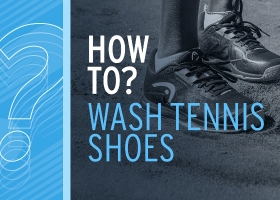How to hold a tennis racquet?
Do you know your Continental or Chopper from your Eastern and your Semi-Western from your Full Western?
There's no one way to grip a tennis racquet. There are several and, as you become more advanced, you'll often find yourself using more than one grip in the same point. To get the most out of your game, you need to know which grip to use and when. Here's our guide to how to grip a tennis racquet, with an introduction to some of the best-known grips as well as answers to frequently asked questions.
What are the best-known grips?
Please note that this guidance is for right-handed players. If you're a left-hander, you should be rotating the handle in the opposite direction. For instance, while a right-hander uses the Continental grip by ensuring that the base knuckle is at bevel number 2, a left-handed player should have the base knuckle at bevel 8.
Continental grip
If you're new to tennis, you should start with the Continental grip. It's also a grip that players of all levels can use for their serves and volleys. The base knuckle should be at bevel 2. Some people call this grip, which is the most traditional and neutral grip, the Chopper grip. As tennis has developed, with modern players looking to generate more topspin with their groundstrokes, the Continental or Chopper grip has become less popular with intermediate and advanced players.
Eastern forehand grip
Imagine you're shaking hands with your racquet - you'll be using an Eastern grip, with the base knuckle at bevel 3. This grip allows you to generate some topspin. Using the Eastern grip, you won't be able to produce as much topspin as you would with the Semi-Western and Western grips.
Semi-Western forehand grip
Grip the racquet so that the base knuckle is at bevel 4. This grip allows you to brush the back of the ball and to generate topspin.
Full Western forehand grip
If the base knuckle is at bevel 5, you're using a right-hander's Full Western grip, which will allow you to produce plenty of topspin. This grip is generally used by advanced players, as beginners won't find it easy holding the racquet like this, especially when trying to hit low balls.
Eastern backhand grip
This is the most popular way to grip your racquet to play a backhand - it allows you to play a flat shot or to come over the ball slightly, generating topspin. The base knuckle should be at bevel 1.
Semi-Western backhand grip
This grip - with the base knuckle at bevel 8 - is recommended for advanced players, allowing them to produce more topspin. The disadvantage of this grip is that it's not so easy to play balls that are bouncing lower.
Two-handed backhand grip
The base knuckle of your right hand should be at bevel 2, while the base knuckle of the left hand should be at 6.
Frequently asked questions:
What is the proper way to grip a tennis racquet?
You can hit most serves using a Continental grip. For a kick serve, you could try using an Eastern backhand grip, which could help you to hit the ball with more spin.
How should a beginner hold a tennis racquet?
You should begin with the Continental and Eastern grips. As you improve and become more confident on court, you can start to experiment with the other grips, but you should wait until you are at a more advanced level before using some of the grips.
How should a kid hold a tennis racquet?
Children can begin by using the Continental and Eastern grips. Like adults, as they improve, they can start trying other grips to see whether it suits their game.
How hard should I hold a tennis racquet?
As a general rule, you should be holding the racquet firmly enough so that if someone was pulling on the other end of the frame they couldn't immediately rip it out of your hand. A firm grip on the racquet will help you to control the racquet when you hit the ball. However, it's possible to be holding the racquet too tightly, which could potentially reduce the touch, feel and spin on your shots.

















